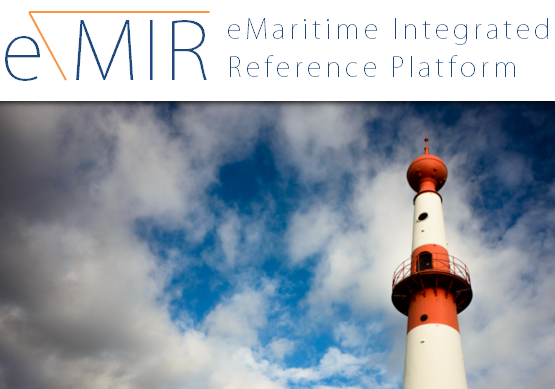1. General Information

eMIR: e-Maritime Integrated Research Platform
- Location: German Bight; Jade/Weser/Elbe approach
- Duration: July 2013-2023
- Status (planned, completed or on-going): ongoing
- Contact: Axel Hahn, hahn@wi-ol.de, OFFIS, Escherweg 2, 26121 Oldenburg, Germany
- Testbed website: www.emaritime.de
- Initial Organisations: OFFIS, University of Oldenburg, SIGNALIS GmbH, Raytheon Anschütz GmbH
- Initial Funding: Research Centre for Critical System Engineering funded by the government of Lower Saxony, 4 Mio. €
2. Executive summary
The reseach platform eMIR is a step forward making maritime systems safe and dependable. Assigned to the Research Center for Critical Systems Engineering at the University of Oldenburg and the Research Institute OFFIS, eMIR is an open test bed in the German Bight. Open means that eMIR understands itself as an element of the world wide efforts to provide test beds for maritime systems like e-Navigation, shipping, or platforms for environmental monitoring.
eMIR is intended to support efforts to implement next generations e-Navigation and intelligent shipping technologies for organizations like IALA and IMO. It will offer research, development, testing, and demonstration services for both industry and academia.
eMIR will support a physical test bed in the south east German Bight in the vicinity the Jade, Weser and Elbe approach and the harbours of Jade Weser Port, Bremerhaven and Cuxhaven. It will be accompanied by a co-simulation system with installations in Elsfleth and Oldenburg in combination with third party simulator installations.
eMIR implements a service oriented approach. It will offer services used to explore new technical solutions, human centered design, verification and validation, demonstration and environmental monitoring. First services under design are:
- Reference Waterway Jade/Weser/Elbe approach
- Reference Offshore Wind Park
- Research Harbour
- Ship to Ship and Ship to Shore Communication
- Traffic Simulation
- Bridge Simulation
- Heavy Lift Simulation
- Environmental Simulation
- Environmental Monitoring
- Vessel Traffic Services (VTS) System
3. Testbed Information
The type of user group/s involved in the test
Shipboard users
Shore-based users
Details of e-Navigation gap/s considered for the testbed
Information/data management
Effective and robust voice communication and data transfer
Systems and equipment
Ship reporting
Traffic monitoring; and/or
Training and familiarization
The category of e-navigation gap/s considered in the testbed
Technical
Operational
Details of e-navigation solution/s considered in the testbed
S1: Improved, harmonized and user-friendly bridge design
S2: Means for standardized and automated reporting
S3: Improved reliability, resilience and integrity of bridge equipment and navigation information
S4: Integration and presentation of available information in graphical displays received via communication equipment
S9: Improved Communication of VTS Service Portfolio
The category of e-navigation solution/s considered in the testbed
Technical
Regulatory
Operational and
Training
Links to similar / relevant testbeds
4. Testbed methodology
Methodology used for data collection
eMIR offers a service oriented research infrastructure consisting of s physical testbed for in situ experiments as well as a simulation environment for risk and efficiency assessments.
- Design supports a system engineering approach based on model driven design of new technologies, cooperation schema and human machine interfaces.
- In situ experiments provide a technology demonstration environment for technical experiments as well for base lining simulation systems.
- For simulation a reference nautical officer is models as a cognitive model for risks and usability assessment.
Summary information on testbed respondents / participants
Not available
Procedure used in the testbed
The physical elements of eMIR cover
- VTS installation
- A portable Integrated Bridge System
- Sensors along the waterways and in the research harbors for traffic and environment monitoring
- Communication backbone
- A set of NaviBoxes, ready to run navigation and surveillance sensors to be used for bridge/e-Nav experiments
- Odysseus Sensor Fusion System
The In Situ testbed is accompanied by a co-simulation system including a
- Traffic Simulation for waterways
- nBody Simulation for operations
- VTS Simulation
- Radar Simulation
- Modeling tools
Interoperability is ensured by using a HLA based backbone and HAGGIS semantic data model. The simulation platform will be extended by
- Bridge Simulator (Jade Hochschule)
- Heavy Lift Simulation (Mariko) and usage of
- Enviromental Models and Simulations (BSH)
- Research Harbour Rostock
5. Testbed results
Summary of findings
All public outcomes about technology evaluation and hmi / usability analysis will be published on the eMIR web page.
6. Conclusions and recommendations
Conclusions
First outcome of test bed setup is the identification of the need to address e-Navigation as a safety critical sociotechnical system.
Recommendations
eMIR is planned as an open and integrative e-Navigation testbed. We suggest to share services with other registered testbeds to push e-Navigation implementation.
7. Publications
To be extended
8. Reference material
To be extended
